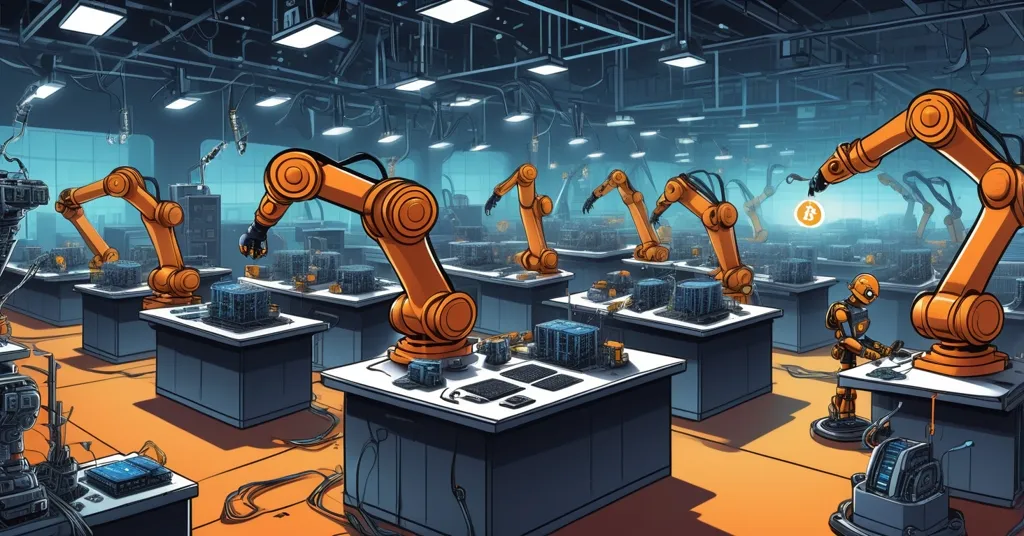Apple’s $100B U.S. Investment: Tariff Dodge or Crypto Hardware Crisis?

Apple’s $100 Billion U.S. Investment: Tariff Dodge or True Pivot for Tech and Crypto?
Apple has unveiled a massive $100 billion commitment to U.S. manufacturing, revealed during a White House event alongside CEO Tim Cook and President Donald Trump. This latest pledge bumps Apple’s total U.S. investment to $600 billion, a strategic play to counter brutal tariff pressures and align with Trump’s domestic production crusade. But could this seismic shift ripple into the world of Bitcoin mining hardware or spark decentralized tech solutions?
- Apple commits $100 billion to U.S. manufacturing, reaching $600 billion total investment.
- Announcement made at White House with Tim Cook and Trump amid trade war escalation.
- Tariffs already cost Apple $800 million, with losses projected at $1.1 billion by September.
Tariff Pain: Apple’s $800 Million Hit and Counting
The backdrop to Apple’s announcement is a trade war that’s hitting harder than a Bitcoin network difficulty spike. With new 25% tariffs imposed on goods from India—due to its Russian oil purchases—and another 25% duty looming, Apple’s supply chain is under siege. Add to that potential levies on semiconductor products, and the financial toll is staggering. Last quarter, tariffs bled $800 million from Apple’s bottom line, with projections climbing to $1.1 billion by September if these trade penalties hold. For clarity, semiconductors are the tiny chips powering everything from iPhones to the specialized rigs Bitcoin miners rely on to secure the network. If costs soar or supply tightens, the pain could extend far beyond Cupertino, as discussed in this analysis of Trump’s trade policies and pressure on tech companies.
Apple’s global operations are deeply entrenched overseas. Most iPhones sold in the U.S. are assembled in India, while MacBooks, iPads, and Apple Watches roll out of Vietnam. These hubs offer lower labor costs—often a fraction of U.S. rates—and established infrastructure that’s tough to replicate stateside. Moving production back to the U.S., or “reshoring” as it’s called, means abandoning these cost advantages to dodge tariffs or meet political demands. It’s a logistical nightmare, akin to rebuilding a blockchain from scratch after a hard fork. Despite the challenges, Apple’s stock jumped 6% intraday after the news, suggesting markets see this as a savvy—if costly—pivot, per this detailed tariff impact analysis on Apple’s investment.
At the White House event, Trump didn’t hold back in touting this as a victory for American industry. White House spokesperson Taylor Rogers doubled down on the narrative:
“Today’s announcement with Apple is another win for our manufacturing industry that will simultaneously help reshore the production of critical components to protect America’s economic and national security.”
Tim Cook, meanwhile, played it cool but dropped a clear hint at the inevitable, as covered in this report on Cook joining Trump at the White House:
“We obviously try to optimize our supply chain. And ultimately, we will do more in the United States.”
Crypto Connection: Could Mining Hardware Costs Spike?
Now, let’s hash out what this means for the crypto crowd. Bitcoin miners and altcoin enthusiasts depend on cutting-edge hardware like ASICs (Application-Specific Integrated Circuits), custom machines built to solve the complex puzzles securing decentralized networks. A high-end ASIC, such as Bitmain’s Antminer S19, runs $2,000 to $3,000 today. Semiconductors make up a hefty chunk of that cost. If a 25% tariff on these chips sticks, rough estimates suggest a price hike of $200 to $450 per unit, assuming a 10-15% cost pass-through. For smaller mining ops already squeezed by energy bills and Bitcoin’s halving cycles, that’s a profitability gut punch, as highlighted in this piece on Bitcoin mining hardware cost increases due to tariffs.
Worse, supply chain disruptions from reshoring could delay new hardware drops. Apple and mining hardware makers like Bitmain often rely on the same global foundries, such as TSMC in Taiwan. If production shifts to the U.S. slow output or inflate costs, expect longer wait times for next-gen miners—bad news when network difficulty keeps climbing. On the flip side, could this spark U.S.-based hardware innovation? Don’t bet your satoshis on it. Manufacturing costs stateside are often double or triple those in Asia, and miners won’t shell out extra for a “Made in USA” sticker. This tariff storm looms like a 51% attack on the crypto hardware market—unpredictable and potentially devastating, with further insights available on Reddit discussions about Apple tariffs impacting Bitcoin mining gear.
Decentralized Solutions: Can Blockchain Fix Supply Chain Woes?
Here’s a wild card worth mining: could blockchain tech help Apple navigate this mess? Decentralized ledgers are already being tested for supply chain transparency. Take IBM’s Food Trust, which tracks goods from farm to table on-chain, ensuring every step is verifiable. Imagine Apple using similar tech to monitor iPhone components from raw materials to assembly, cutting fraud and inefficiencies while proving U.S. production to dodge tariffs. Smart contracts could automate supplier payments, slashing overhead as production shifts stateside. It’s a long shot—Apple isn’t exactly chanting “in Bitcoin we trust”—but the parallels to decentralization’s ethos of cutting out middlemen are hard to ignore, with related discussions on how tariffs affect semiconductor costs for tech and crypto.
Even the buzz around robotics for U.S. assembly ties into the tech-driven progress we champion as effective accelerationists. Automated factories could slash labor costs, much like Bitcoin mining efficiency skyrockets with better hardware. If Apple pulls this off, it might lower costs industry-wide, potentially benefiting mining rig makers long-term. Sure, it’s speculative, but accelerating tech adoption is what decentralization is all about—whether it’s a blockchain or a robot arm assembling your next iPhone.
Reality Check: Apple’s History of Broken Promises
Before we get too hyped, let’s not drink the Kool-Aid just yet. Apple’s track record on economic pledges is shakier than a shitcoin’s whitepaper. Their prior $500 billion U.S. investment promised 20,000 jobs through projects like a server site in Houston and a supplier training center in Michigan. What did we get? A measly $39 billion in actual new spending and about 1,000 jobs annually beyond existing plans. That’s not a pivot; it’s a PR spin. This new $100 billion pledge might just be another flashy ICO—lots of promises, little delivery. And with U.S. manufacturing costs still towering over Asia’s—think $15-20/hour wages versus $2-5 overseas—the economics of reshoring look more like a pipe dream than a plan, as detailed on Apple’s U.S. manufacturing history on Wikipedia.
Trump’s agenda, often dubbed economic nationalism, prioritizes domestic jobs and industries over global trade perks. It’s got echoes of Bitcoin’s push for sovereignty—cutting reliance on centralized, often foreign, systems. But let’s not kid ourselves: Trump’s top-down tariffs are a far cry from crypto’s bottom-up freedom. Apple’s moves are driven by profit and pressure, not some noble quest for independence. If this pledge flops, we’ll call it out—no love for empty hype here, whether it’s from corporate giants or rug-pull scammers. For more on the broader context, see this report on Apple’s $100 billion commitment amid Trump’s influence.
Bitcoin’s Contrast: A Philosophical Edge
Zooming out, Bitcoin offers a stark contrast to Apple’s centralized chess game. While Cupertino bends to geopolitical winds, Bitcoin’s decentralized nature laughs in the face of borders and tariffs. Miners don’t care where their hardware’s made as long as it hashes. Yet, if semiconductor costs spike, even the most die-hard Bitcoin maximalist might feel the squeeze. Here’s a devil’s advocate thought: could the crypto community push tech giants like Apple for hardware price transparency via on-chain data? Probably not, but the idea of holding centralized behemoths accountable with decentralized tools is pure poetry for privacy and freedom advocates like us.
What’s Next for Tech and Crypto?
Peering into the future, Tim Cook is clearly hashing out a new block in Apple’s strategy—let’s see if it confirms. Historically, he’s dodged tariff bullets with exemptions during Trump’s first term, and this $100 billion feels like a familiar sidestep. But with India and Vietnam as supply chain linchpins, and trade penalties stacking up faster than mempool fees in a bull run, the stakes are sky-high. Reshoring via robotics might cut costs eventually, but the upfront investment and logistical chaos are brutal. For crypto folks, the real watch is on hardware costs and delays. Will Apple’s pivot inspire tech giants to explore decentralized fixes, or are we just witnessing another corporate shuffle? Only the immutable ledger of time will tell. For deeper insight into specific tariff impacts, check this report on 25% tariffs on Indian goods affecting Apple’s iPhone production.
Key Takeaways and Questions on Apple’s Investment
- What’s the big deal with Apple’s $100 billion U.S. investment?
It’s a major push to boost domestic manufacturing, totaling $600 billion in U.S. commitments, aimed at dodging tariffs and aligning with Trump’s economic goals, though its real impact remains uncertain. - How are tariffs hitting Apple, and could this affect crypto hardware?
Tariffs cost Apple $800 million last quarter, potentially rising to $1.1 billion by September; semiconductor levies could hike Bitcoin mining rig prices by $200-$450 per unit, squeezing miners’ profits. - Could blockchain tech help Apple’s supply chain challenges?
Yes, decentralized ledgers could track components transparently, as seen in projects like IBM’s Food Trust, while smart contracts might automate deals, cutting costs during reshoring. - Is Apple’s pledge genuine, or just political optics?
Past promises fell short—$500 billion yielded far fewer jobs than hyped—so this $100 billion might be more about appeasing tariff threats than delivering transformative U.S. growth. - Does Trump’s push for domestic production vibe with decentralization?
There’s a shared theme of reducing foreign reliance, like Bitcoin’s ethos, but Trump’s coercive policies clash with crypto’s voluntary, bottom-up approach to freedom and sovereignty.



